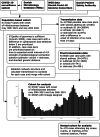Increased transmission of SARS-CoV-2 in Denmark during UEFA European championships
- PMID: 35317884
- PMCID: PMC9254153
- DOI: 10.1017/S095026882200019X
Increased transmission of SARS-CoV-2 in Denmark during UEFA European championships
Abstract
Denmark hosted four games during the 2020 UEFA European championships (EC2020). After declining positive SARS-CoV-2 test rates in Denmark, a rise occurred during and after the tournament, concomitant with the replacement of the dominant Alpha lineage (B.1.1.7) by the Delta lineage (B.1.617.2), increasing vaccination rates and cessation of several restrictions. A cohort study including 33 227 cases was conducted from 30 May to 25 July 2021, 14 days before and after the EC2020. Included was a nested cohort with event information from big-screen events and matches at the Danish national stadium, Parken (DNSP) in Copenhagen, held from 12 June to 28 June 2021. Information from whole-genome sequencing, contact tracing and Danish registries was collected. Case-case connections were used to establish transmission trees. Cases infected on match days were compared to cases not infected on match days as a reference. The crude incidence rate ratio (IRR) of transmissions was 1.55, corresponding to 584 (1.76%) cases attributable to EC2020 celebrations. The IRR adjusted for covariates was lower (IRR 1.41) but still significant, and also pointed to a reduced number of transmissions from fully vaccinated cases (IRR 0.59). These data support the hypothesis that the EC2020 celebrations contributed to the rise of cases in Denmark in the early summer of 2021.
Keywords: Epidemiology; SARS-CoV-2; mass events; public health; transmission.
Conflict of interest statement
None.
Figures


References
-
- Statens Serum Institut (2021) Denmark COVID-19 dashboard. Available at https://experience.arcgis.com/experience/aa41b29149f24e20a4007a0c4e13db1d (Accessed 25 August 2021).
-
- Danish Covid-19 Genome Consortium (2021) Genomic overview of SARS-CoV-2 in Denmark. Available at https://www.covid19genomics.dk/statistics (Accessed 26 August 2021).
MeSH terms
Supplementary concepts
LinkOut - more resources
Full Text Sources
Medical
Miscellaneous

